Adorning the Ves dancer from head to toe
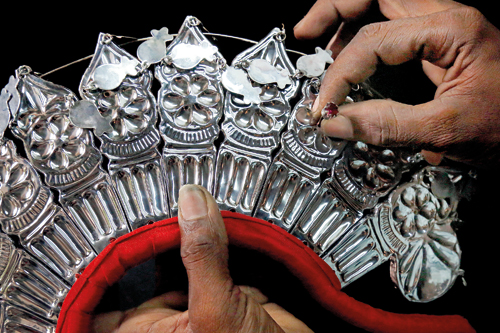
Crowning ornament: Attaching stones to the Ves thattuwa. Pix by M.A. Pushpa Kumara
Not only a Ves dancer but also one of the few creators of the handcrafted ornaments, the repository of which is a ‘Ves Pettiya’, Ratnayake Mudiyanselage Anura Kumara has just accepted the invitation to be part of the Guru Gedera Festival.
As he goes back home to Piliyandala, we follow suit to learn about his craft which is becoming extinct, falling victim to the quicker and easier machine-cut parodies.
With Ves being a signature dance form performed only by men under the Kandyan dance tradition, the Ves Pettiya holds each and every item of the Ves costume with its su-seta abharana (64 ornaments), said to be a replica of what God Kohomba wore, in whose honour the Kohomba Kankariya is performed to invoke blessings on the people. Usually, a dancer earns the privilege of dancing Ves after mastering the art of this ritual with origins believed to be in purification ceremonies.
These ornaments are what 61-year-old Anura is adept at crafting.
Accepting with humility that most of the current veteran Ves dancers use the intricately-carved abarana produced by him, Anura says that many of them will take to the streets during the Kataragama Perahera this month and the Kandy Perahera next month.
However, the older dancers use those passed down from generation-to-generation, he says, citing Ravibandu Vidyapathi who uses those of his family members who danced before him and Kulasiri Budawatte from his father.
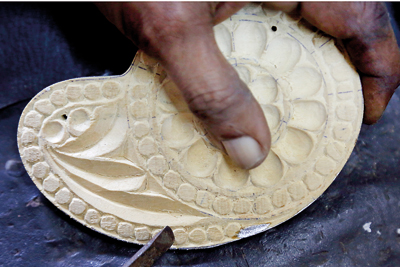
Carving out the mango-shaped thodu path made of Kiriwalla wood
These days, Anura is shaping, cutting, fixing and drilling metal to meet a request by the Horana Educational Zone for 30 Ves Petti for boys and 58 pahinpatha for girls.
Creating the magnificent image of a Ves dancer, before highlighting all the metal accessories worn by him, Anura details the pieces of cloth in the costume, which has 108 knots in it. The clothes include the hangala (the pleated cloth worn around the waist); the mes kalisama (the pants); the two kakul pati (bands worn around the ankles); the poth pota and naru deka (pleated cloths worn around the waist); and the ul udaya (the crumpled cloth worn around the lower half of the body).
The metal and bead accessories are the Ves thattuwa (shikha bandhanaya) and nettimalaya (headgear and crown-like ornament attached on top); the jatawa and jata patiya (head ornaments); the pahinpatha (to cover the jatawa); the thodu path (2 mango-shaped ear-guards); the kara patiya (necklace worn with colourful beads); the avul-heraya (web-like ornament worn to cover the chest, made with beads); the ina hadaya, ina bubula patiya (worn around the waist); the ura bahu and kaimetta (cobra-shaped sheaths over the shoulders and bracelets); the 10 bandi walalu (brass bangles); and the silambu (foot ornaments).
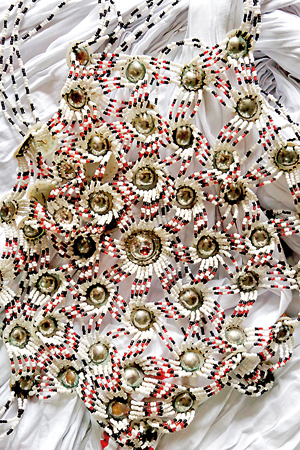
The beaded Avul- heraya (worn on chest)
The Ves Pettiya was traditionally a woven square box with double lids, usually kept not in the home of the dancer but in a separate shrine-room or in the village temple and when taken among the public is covered with a white cloth.
“Ves thattuwa should be created according to precise measurements, so that it can be worn by anyone,” says Anura, laughingly pointing out that oluwe size eka wenas wunata, onema kenekta adinna puluwan venna one. (Even though the head-size of the dancers may vary, anyone should be able to wear it.)
When Anura gets an order, bleary-eyed he would be, burning the midnight oil to deliver the stuff on time, handcrafting all the metal pieces himself.
We see him at work in a small shed in his backyard, while he takes us through the processes step-by-step. The design of the ornament is carved onto a wooden board which serves as the mould to create the metal ornament by Anura, who explains that the wood is from the ‘kiriwalla’ tree which has a smooth fine-grained, yellow-white texture, which he gets from Kegalle and Kurunegala.
Then he keeps the wooden mould on a copper or brass sheet which has been electroplated with nickel and chromium to give the sheen of silver, as silver is very expensive, after which the shape is cut, keeping an extra margin all round. Small slits are put around the extra margin and the margin is folded to cover the edge of the mould and hammered into place to make the outline even.
“I use a special type of ‘panel pins’ which are not prone to rusting imported from India, to nail the nickel margin around the edge of the wooden mould. Then I use the ‘bola katta’ (a small piece of chalk-like tool made with iron and plastic which has a curved end) to press the metal into the mould and take the design onto the metal sheet,” says Anura differentiating it from the ‘iri katta’ (a tool like a piece of candle made with plastic) which is used for subtle designs.
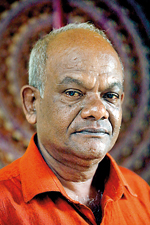
Anura: Rare craftsman
Holes are then drilled to attach the stones, both synthetic and topaz (Nil Padiyan) imported from Bangkok, to the top, after which the spokes (angili) of the Ves thattuwa are connected with galvanized wire.
Anura is very specific – “It’s either 13 or 15 spokes in a Ves thattuwa,” he says, adding that thereafter Bo-leaves are attached to the tip of each spoke with a small hook (gunduwa).
For Anura, his craft is not a paaramparika one (not handed down from generation to generation), but something he got into, after passing the Ordinary Level (OL) and Advanced Level (AL) examinations in science very well, three marks short of entering the medical faculty. He recalls how he asked his mother for Rs. 7,000 to buy a tractor, refusing categorically to sit for the second shy of the AL.
The dancing lessons of the well-known master, D.L.S. Perera (Niyadagala Perera) at the Rattanapitiya Ananda Vidyalaya, had been a strong attraction for Anura even as a little boy and it was after the ALs that he decided to take to dancing as a teaching career.
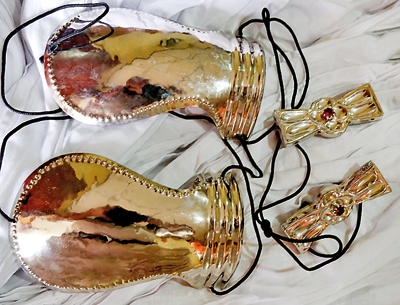
Ura bahu and Kaimetta: Cobra-shaped sheaths over the shoulders and bracelets
To Kalugamuwa in Kurunegala he headed, to learn dancing doubled up with wood carving from ‘Sethan Gurunnanse’, after offering him kalu suruttu, a tot of arrack and sometimes a little fish or meat.
He recalls those times in the humble and tiny home of Sethan Gurunnanse who lived with his wife and two beautiful daughters. The family of four shared the one-and-only bedroom and Gurunnanse’s apprentice, Anura, roughed out in the wadu maduwa to master the art of abarana-crafting.
When asked how Sri Lanka can revive this dying art, where handcrafting has given way to mass production with machines, he laments that many are giving up this craft due to financial hardship.
“The taxes affect us the small craftsmen, as the metal is imported from India and the stones from Malaysia. These artists should at least be given a loan plan to develop their businesses,” Anura says, happy though that of his three children, his youngest son, Lahiru, is keen to follow in his footsteps, already showing much promise.
Anura’s fervent wish is that more young people will take up the craft, with strong government support.
| Guru-Gola bond and a Guru Gedera Festival | |
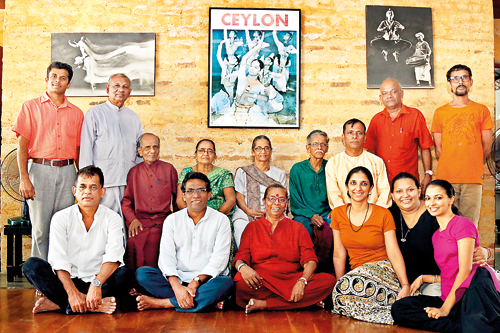 Keeping tradition alive:Leading proponents of Kandyan dance Seated in a circle below a large portrait of the late doyen of Kandyan dance, the intense discussions are all about traditional arts and crafts which are dying gradually and may not live to see the future. Gathered at the beautiful Chitrasena Kalayathanaya at Narahenpita this rainy Wednesday, with a heavily overcast sky sending down sudden showers, are several Gurunnanses who have braved the inclement weather to hear and accept heartfelt invitations from the Chitrasena-Vajira Dance Foundation. In the muted glow of the dimly-lit Kalayathanaya, this is about the Guru-Gola bond and they are being invited to be part of the Guru Gedera Festival. There is a bustle of excitement when Vajira herself walks in and the dance family and the Gurunnanses gather for a photograph under the benevolent gaze of Chitrasena who is no more.
|


